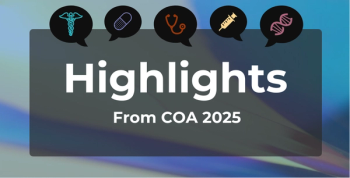
Early Signs of Promise as Yale's Herbst Details PD-L1 Immunotherapy Data
Results detailed today offer hope that a new form of immunotherapy will propel the bodies of some cancer patients to fight tumors, not be overrun by them, according to a study outlined at the Annual Meeting of the American Society of Clinical Oncologists (ASCO) in Chicago.
Results detailed today offer hope that a new form of immunotherapy will propel the bodies of some cancer patients to fight tumors, not be overrun by them, according to a study outlined at the Annual Meeting of the American Society of Clinical Oncologists (ASCO) in Chicago.
Roy S. Herbst, MD, PhD, the study’s lead author, said patients in a phase I study demonstrated a 21% response rate when the antibody MPDL32802 was aimed at the programmed death ligand 1 (PD-L1), to unleash the body’s immune system.
Herbst , professor of Medicine at Yale Cancer Center and chief of Medical Oncology at Smilow Cancer Hospital at Yale-New Haven in Connecticut, has described these findings as “the tip of the iceberg,” with broad implications for treatment.
“This therapy has the potential to be used in almost every tumor type,” he said recently. “We’re still figuring out exactly what the right biomarker is going to be to predict the most responsive population.”
MPDL3280A produced durable responses with no dose-limiting toxicities and a favorable adverse event profile in heavily pretreated patients, Herbst said.
In the study, MPDL3280A was administered intravenously every 3 weeks to patients with metastatic tumor types including non-small cell lung cancer (NSCLC), melanoma, colorectal cancer, gastric cancer, and renal cell carcinoma. Responses were assessed with computed tomography scans every 6 weeks for 6 months and then every 12 weeks.
In all, 29 of 140 evaluable patients (21%) exhibited tumor shrinkage according to RECIST criteria, with the highest overall responses in patients with NSCLC and melanoma. Of the 29 responders, 26 patients continued responding as of their last assessment. Responders were on the study from 3 months to more than 15 months.
In a biomarker analysis, responses were better among patients with higher levels of PD-L1 expression. The response rate among PD-L1-positive patients was 36% (13 of 36 patients), compared with 13% (9 of 67 patients) who were PD-L1-negative.
The role that PD-L1 expression might play as a biomarker is still being explored, Herbst said. Methods of measuring the protein, the nature of the tumor samples used to analyze its expression, and the levels that would predict a response to therapy are among the questions that remain unanswered.
For the safety analysis, results were available for 171 patients. A total of 43% of patients experienced grade 3/4 adverse events (AEs), most commonly hyperglycemia (5%), fatigue (4%) and increased alanine aminotransferase levels (3%). However, investigators determined that 13% of the grade 3/4 AEs were attributable to the drug, and there were no treatment-related deaths, Herbst said.
Moreover, only 2% of the participants (4 patients) experienced grade 3/4 AEs that were deemed to be immune-related, and only one patient discontinued treatment because of an immune-related AE.
“We didn’t see any high-grade pneumonitis, which makes us feel very optimistic that this drug, because it’s hitting only the PD-L1, is probably sparing some of the mechanisms that would allow for the lung to become inflamed,” Herbst said in the interview.” We saw a couple episodes of hepatitis and liver inflammation but really, it’s a very mild toxicity profile.”
Findings Generate Excitement
MPDL3280A is the latest example of the checkpoint blockade anticancer strategy pioneered with the development of ipilimumab (Yervoy), which unlocks the power of the immune system by targeting CTLA-4. The FDA approved the melanoma drug in 2011.
Herbst said the efficacy demonstrated thus far in attacking PD-L1 and other immune checkpoints “gives us the opportunity to open up a whole new avenue of therapy in cancer.”
Tumor cells express PD-L1, which in turn binds to the T-cell receptors PD-1 and B7.1, Herbst said. “As long as there’s PD-L1 on the surface of the tumor, the T cell PD-1 sees it as a friend,” he said. “It is cloaked and it doesn’t recognize the tumor as a foreign body and it doesn’t kill it. But as soon as that PD-L1 goes away by blocking it with an antibody the tumor becomes visible, the target can be lit up, you go after it, and the T cell attacks and kills it.”
Herbst said the therapeutic strategy could apply to a variety of cancers. “Any tumor type that has mutations is going to have the potential to be immunogenic and to work in this way to activate the immune system,” he said, adding that “a lot of patients don’t have a driver mutation that’s easily targetable.”
Since MPDL3280A has been engineered for enhanced safety, the agent could potentially be combined effectively with targeted therapies or with chemotherapy, Herbst noted. “The ability to combine this is going to be extraordinary,” he said.
The MPDL3280A study is continuing with an expanded cohort of patients with a larger range of solid tumors and blood cancers; more than 275 patients have been enrolled, ASCO announced prior to today’s session.
Genentech, which is developing the drug, also is investigating MPDL3280A in separate phase I trials in combination with vemurafenib (Zelboraf) in patients with BRAF V600 mutation-positive metastatic melanoma and in addition to bevacizumab (Avastin) with or without chemotherapy in advanced solid tumors, as well as in a phase II study as monotherapy in PD-L1-positive locally advanced or metastatic NSCLC.
Herbst RS, Gordon MS, Fine GD, et al. A study of MPDL3280A, an engineered PD-L1 antibody in patients with locally advanced or metastatic tumors. J Clin Oncol. 2013;(suppl; abstr 3000).
Newsletter
Stay ahead of policy, cost, and value—subscribe to AJMC for expert insights at the intersection of clinical care and health economics.








